Hamadryas Baboon (Papio hamadryas)
MORPHOLOGY:
The average body mass for an adult male hamadryas baboon is between 20 and 30 kilograms, and for the female it is between 10 and 15 kilograms. This species exhibits sexual dimorphism, especially in body size. The males have a large mantle of hair surrounding their head.
RANGE:
The hamadryas baboon is found in the countries of Ethiopia, Saudi Arabia, Somalia, and Yemen. This species lives in the subdesert steppe, alpine grass meadows and short grass plains environments. |
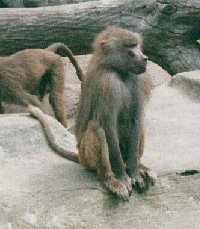 |
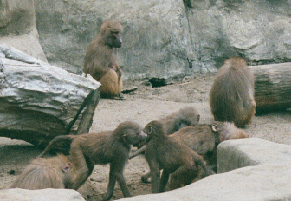 |
ECOLOGY:
The hamadryas baboon consumes a wide variety of foods, but main sources come from grasses, rhizomes, roots, tubers, and shoots. They also consume fruits, leaves, flowers, and small vertebrates, but to a lesser extent. Food resources are generally widely dispersed. The favorite foods during the rainy season consist of Acacia flowers and grass seeds (Stammbach, 1987). The hamadryas baboon sleeps in rock outcroppings generally from 15 to 25 meters high, and a lack of this limits where it can live and forage. This is a diurnal species. The basic group size averages around 12 individuals with these groups coming together to form groups of up to 750 individuals.
LOCOMOTION:
The hamadryas baboon moves on the ground quadrupedally (Fleagle, 1988). |
SOCIAL BEHAVIOR:
The basic group of the hamadryas baboon consists of one male with 2-11 females; a unimale group, essentially a harem system . These groups come together to form troops of up to 750 individuals to sleep on outcroppings of rocks at night. During the day these large troops break up into smaller groups of 20 to 70 individuals made up of two or more unimale groups. These are foraging groups that stay together while they forage. Two or three unimale groups will come together to form what is known as a clan, and the males found in the clan tend to be genetically related (Abegglen, 1984). These clans come together to form larger groups called bands, and three or four bands come together to form troops that sleep together on the rocks (Stammbach, 1987). So there is a four-tier social system within the hamadryas baboon, first the unimale group, or harem, then the clan made up of a couple of unimale groups, then the ban made up of a number clans, then finally the troop which comes together during the night for sleeping purposes. Generally males stay in their natal group and females migrate from it (Stammach, 1987). Males when they reach puberty try to either attract or kidnap females to start a unimale group of his own. Harem-less males will also join a harem with an old resident male and basically serve as a "stud" while the older male remains as a patriarch and leads the harem (Estes, 1991). Within the unimale group there is a hierarchy that exists amongst the females, the central female has higher status in a social sense and is located more near the male during the day. In the unimale group when a female strays or lags behind, the male will sometimes bite her on the neck to get her going. The male of the unimale group is the focus of the attention of grooming by the females (Kummer, 1968). |
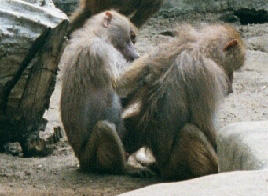 |
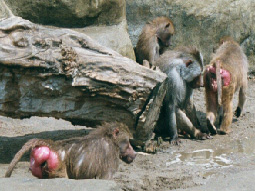 |
VOCAL COMMUNICATION:
two-phase bark: This is a deep, loud call which is repeated at 2 to 5 second intervals (Estes, 1991). This sounds like "wahoo" and is emitted by adult males (Estes, 1991). This call is emitted when a predator is near especially a feline one (Estes, 1991). This call is also heard when their is inter or intra group aggression between males (Estes, 1991). This call communicates male presence and arousal (Estes, 1991).
rhythmic grunts: This call is low and soft and is given by all hamadryas baboons except infants (Estes, 1991). This call is given when one individual is approaching another and signals friendly intentions (Estes, 1991).
shrill bark: This call is a sound which is single, sharp, and explosive in nature (Estes, 1991). This call is emitted by all hamadryas baboons except adult males, and functions as an alarm signal especially to a sudden disturbance (Estes, 1991). Other members of the troop will flee upon hearing this call (Estes, 1991). |
OLFACTORY COMMUNICATION:
VISUAL COMMUNICATION:
social presenting: This is like presenting, but is done by females and juvenile males towards higher ranking males (Estes, 1991). This is a submissive display and differs from presenting by the hindquarters being lower.
staring: This display by the hamadryas baboon is used as a threat display (Estes, 1991). The eyes are fixed on the stimulus and the eyebrows are raised and the scalp is retracted, the facial skin is also stretched by moving the ears back (Estes, 1991). Underneath the eye lids the color is different which contrasts sharply with the surrounding facial color (Estes, 1991)
staring with open mouth: This is the stare accompanied by the mouth being open but the teeth are covered (Estes, 1991). This is a threat expression and often occurs with head-bobbing (Estes, 1991).
head-bobbing: This is used as a threat display by the hamadryas baboon and head bobs up and down (Estes, 1991). This often occurs with staring with open mouth (Estes, 1991).
tension yawning: This is done by an adult male hamadryas baboons (Estes, 1991). This is when the mouth is opened fully to reveal the canines (Estes, 1991). This is done when a rival group or a predator is approaching (Estes, 1991).
teeth-chattering: This is done by a male hamadryas baboon to a female that is presenting (Estes, 1991). This is probably derived from lip-smacking (Estes, 1991).
lipsmacking: This is when the lips are protruded, then smacked together repeatedly. This is a reassuring display by the hamadryas baboon (Estes, 1991).
TACTILE COMMUNICATION:
social grooming: This is when one individual removes parasites and dead skin with their hands from another individual. In this species it generally only occurs between same sex individuals. This is used to reinforce the social bonds.
nose-to-nose greeting: When two individuals meet each other they touch noses as a friendly sign (Estes, 1991).
social mounting: This is generally a response to social presenting and serves to signal a friendly reassurance (Estes, 1991). This is also seen during aggressive encounters (Estes, 1991).
REPRODUCTION:
The hamadryas baboon gives birth to a single offspring. During estrus the perineum of the female swells up.
presenting: This behavior is preformed by the female to elicit copulation from the male; this pattern tells the male that she is ready for copulation (Estes, 1991).
REFERENCES:
Abegglen, J.J. 1984. On Socialization in Hamadryas Baboons. Associated University Presses, Cranbury, N.J.
Burton, F. 1995. The Multimedia Guide to the Non-human Primates. Prentice-Hall Canada Inc.
Estes, R.D. 1991. The Behavior Guide to African Mammals. University of California Press.
Fleagle, J. G. 1988. Primate Adaptation and Evolution. Academic Press.
Kummer, H. 1968. Social Organization of Hamadryas Baboons. University of Chicago Press.
Stammbach, E. 1987. Desert, Forest and Montane Baboons: Multilevel-societies. In Primate Societies, eds. B.B. Smuts, D.L. Cheney, R.M. Seyfarth, R.W. Wrangham, and T.T. Struhsaker. University of Chicago Press. |
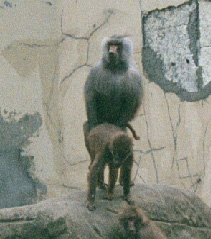 |
Last Updated: October 12, 2003.
[The Primata] [Primate Fact Sheets] [Subfamily Cercopithecinae] [Papio Links]




